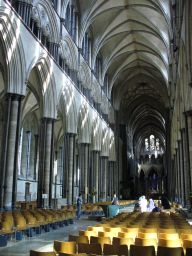Salisbury was our second stop between Bath and Brighton on Saturday. We stopped for lunch, wandered the city's old quarter, and toured its famed cathedral. The entire experience was full of the most unexpected surprises.
The first surprise came as we wandered along the banks of a river bordering the central car park. Large fish were swimming in the clear, shallow, fast-flowing stream. I can't recall ever seeing so many large fish in a river so clear and shallow. Salisbury sits at the heart of five rivers: the Nabber, Ebble, Wylye, and Bourne. All are tributaries of the Avon, the same river that flows through Bath.
The city's origins date back to Iron Age. It was called Sorviodunum by the Romans and listed in the Norman Domesday Book as Salesberie. The Normans built the city's first cathedral between 1075 and 1092. By 1220, poor relations between the clergy and the military led to a decision to resite the cathedral elsewhere. Thus the city of New Sarum, known as Salisbury, was founded and construction of a new cathedral began the same year. Incredibly, the main building took only 38 years to build.
The cathedral presented a series of surprises for Garry and me. First, the building itself sits in the midst of green parkland surrounded by trees and open space. Every cathedral I ever recall seeing was always surrounded by paved plazas and other artificial constructs. To find such an enormous building in the midst of a green oasis was most unexpected.
We joined a wonderful old lady for a guided tour of the cathedral. She shared the most fascinating stories of knights, kings and battles behind many of the tombs scattered throughout the cathedral. It was here that we had one final surprise. Prime Minister, Edward Heath, is buried close to the tomb of William Longespee, the first person to be buried in the cathedral. It was hard to fathom that almost 800 years of history now separate these tombs.
Our final adventure in Salisbury was lunch at the national Italian restaurant chain, Prezzo. The restaurant itself was located in a restored heritage-listed building close to the cathedral grounds. Built in the Middle Ages, the building has suffered subsidence over the centuries, to the point that the floor slopes in one direction, the ceiling in another. Each wall was clearly a custom restoration, each irregularity only adding to the restaurant's charm.










1 comment:
Salisbury in the winter is one of the most picteresque places I've been fortunate enough tovisit. I can only imagine what it's like when all of the white is replced with the green foliage of warmer weather.
As for the Prezzo restaurant within the heritage building this is something I'm seeing a lot of with regards their new venues. It makes each restaurant unique and, while at odd with their Italian cuisine, adds a great charm to the chain.
Post a Comment